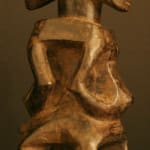Hemba Wooden Janiform Sculpture, 20th Century CE
3.75 x 8.75
SP.137
Further images
On a round pedestal, a male and female figure stand back to back, their bodies joined except for the legs that separate at the hips. Their facial features are quite...
On a round pedestal, a male and female figure stand back to back, their bodies joined except for the legs that separate at the hips. Their facial features are quite similar, with the female displaying a more pronounced elongation of the lips and eyes, and the male wearing a beard made in a checkerboard pattern like the conical headdress they both share. The shoulders are very wide and solid, the neck thick, the short stocky legs bent at the knees. Each figure places their hands on an extended stomach in the manner of Hemba ancestral statues. Scarification in a triangular pattern extends from the middle of the female’s breasts to just above her navel. This statuette is in fact similar to the well-known kabeja figures, with the exception that it is not a receptacle. Its power lies in its representation of female and male unity, with an overt sexual and fertility connection







